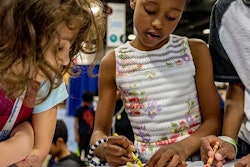Last month, a group of high school girls gathered in Charlotte, N.C., to attend “DigiGirlz,” a Microsoft program designed to make once male-dominated STEM fields seem less daunting. Microsoft’s DigiGirlz camps, scattered in various locations across the country, aim to combat entrenched stereotypes about the role of women in technology.
The camp kicked off on July 18 with a pep talk from local politicians, Senator Kay Hagan, D-N.C., among them. Participating students, girls in grades 6 through 11, learned about the benefits of careers in technology and about local educational programs in Charlotte.
Later in the day, the girls took an Internet safety course, where they learned how to pre-emptively ward off unwanted intruders on social media sites like Twitter and Facebook.
The rest of the week was devoted to basic programming courses, Microsoft Office workshops, and even a self-defense course from local martial arts instructors.
Keami Lewis, a senior manager for Development & Outreach, Global Diversity and Inclusion for Microsoft, says that DigiGirlz tries to stay connected to students even after the program ends.
Microsoft makes curriculum recommendations to local colleges and high schools and offers internships for girls who participate.
“I think it’s a great opportunity for girls and women in particular since statistically they represent such a small percentage of those who are involved in the field,” Lewis says. “So there’s a growing opportunity for women and girls to impact those numbers and build a lucrative career in technology.”
But increasing the percentage of women in science and technology also will improve technology itself, says Catherine Ashcraft, who is a senior research scientist at the National Center for Women & Information Technology (NCWIT).
“The world is diverse, and, if only one group of people is inventing the technology for the world to use, you tend to not have as good a technical product,” she says.
Ashcraft adds that young girls often have preconceived ideas of what a technologist should look like, and they often feel that they don’t fit the profile.
“There are messages that girls get either subtly or not so subtly about who are the kinds of people who do technology,” she says. “In popular culture it’s often not girls who do the inventing.”
And girls who do develop an interest in technology suffer from a lack of role models, Ashcraft says. “They find they are often the only girl in the class. It’s intimidating and difficult for them.”
But research suggests that teams with diverse members—and a wider range of perspectives—create more innovative products.
Jennifer Goodall, Assistant Dean of the College of Computing and Information at the University of Albany, recalls how she attended a conference in which a female speaker struggled to accommodate a badly designed microphone.
“She said that you can tell the mic was designed by a man because it was made [to fit into] a pocket,” she says. Most women’s suits do not come with pockets.
Goodall helped organize a DigiGirlz Day at the University of Albany on April 13.
The University of Albany also hosts two popular technology programs geared to middle and high school students: a Junior FIRST Lego League Expo, aimed at 6- to 9-year-old students of both sexes, and a social robotics workshop, for middle school students.
Though these programs take place on a college campus, the importance of college education is a message that’s implied, rather than overt, Goodall says.
“Because it’s such little kids, college is nowhere on their radar,” Goodall adds. “But we try to make the campus fun.”
Kids are often turned off by heavy-handed messaging, she says, but will readily dive into projects that they feel are relevant to their daily lives. Each technology program strives to balance levity with seriousness of purpose, she says.
During the robotics workshop, for example, students are challenged to design robots with unique personalities.
“It’s programming, but not just for the sake of, ‘oh let’s make it move,’” Goodall says.
Ashcraft says that, when it comes to introducing girls to science and technology, programs like DigiGirlz strike the right tone.
“A lot of the things we recommend are actually good for increasing girls participating, but they’re good for increasing all students’ participation,” she says. “Things like making it relevant, making it engaging and hands-on so that it’s not just learning algorithms straight out the gate but connecting it to things kids can do,” she says.
Goodall says that the atmosphere of college campuses makes a deep impression on children, who are often unsure of what to expect.
“It’s sort of a subliminal message of, here’s kids doing this and thinking it’s fun and thinking it’s cool,” she says. “We’re here, and we’re fun, and we’re dressed really casually. It doesn’t have to be a big, scary place that they could never go to.”


















